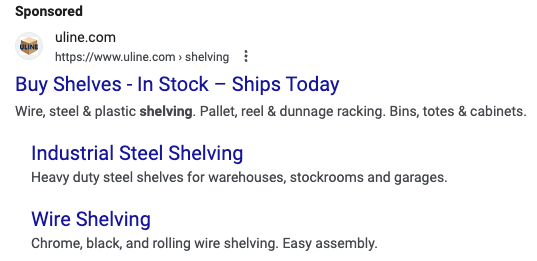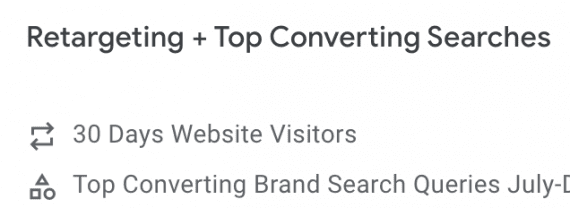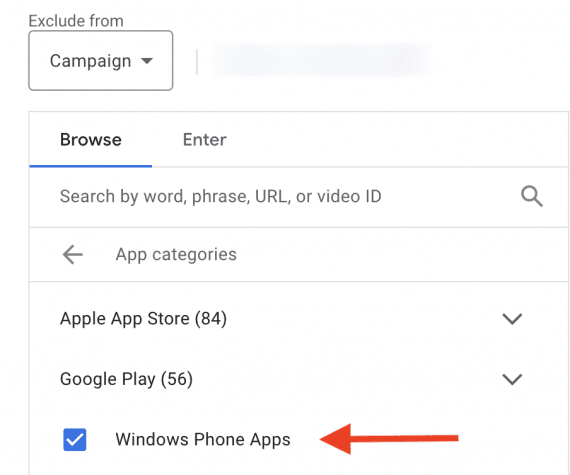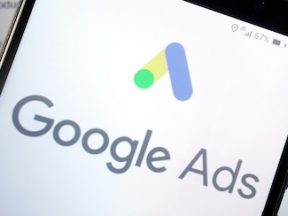Full-funnel marketing turns people unfamiliar with your brand into customers. It’s typically a three-stage process:
- Awareness. Interest in your brand.
- Consideration. Evaluation against competitors.
- Conversion. Desired action.
The stages are part of a funnel. Awareness is at the top, consideration is in the middle, and conversion is at the bottom. Let’s review each, beginning at the bottom.
Bottom-of-funnel
Remarketing — advertising to folks who have been to your site or have taken a specific action — is a common bottom-of-funnel tactic. Those consumers presumably know what you offer. The goal is providing the final reason to convert, such as reinforcing your brand or extending an offer.
Targeting high-purchase-intent searches is another BOFU strategy. For example, a search for “buy shelves online” is high intent. Uline’s ad for that query, below, emphasizes the shelves are available and can ship today.

Uline’s ad for “buy shelves online” emphasizes its shelves are available and can ship today.
Search terms with modifiers frequently convey advanced purchase intent. Thus “wire basket shelving” likely has more intent than “shelving units.” High-intent search terms should produce ad copy and landing pages relevant to those queries.
Google’s Performance Max campaigns can target bottom-of-funnel searchers. Performance Max isn’t as transparent as other campaign types, but you can utilize audiences likely to purchase. Submit audience signals to inform the algorithm of ideal customer personas. It will then look for those users.
The example below starts with audience signals of website visitors in the last 30 days and top converting brand searches. Google will expand on this list to find similar audiences.

This Performance Max campaign starts with audience signals of website visitors in the last 30 days and top converting brand searches.
Another BOFU tactic is ensuring bid strategies optimize the right conversions. A campaign with purchases as the main goal should apply only that conversion action as the bid strategy. Campaigns with multiple actions — such as purchases, email signups, form submissions — and a max conversion bid strategy force Google to optimize for the most overall conversions, not just purchases.
Campaigns with no assigned actions use the account’s default conversion settings.
Optimizing for the right conversions applies also to higher-funnel campaigns. A prospecting campaign could optimize for, say, email signups since consumers are in the awareness stage.
Middle-of-funnel
Middle-of-funnel tactics target prospects who know what they want and are aware of brand options. MOFU searchers often compare those brands. Ad strategies for MOFU consumers could skew toward the top or bottom of the funnel.
Most Google Shopping campaigns are MOFU because searchers are comparing and evaluating. Campaigns utilizing audiences and customer lists with the targeting feature (meaning prospects search on the keyword and are part of a targeted audience) are closer to the bottom of the funnel. A Shopping campaign with a single bid for a brand’s entire product assortment is near the top.
Search campaigns targeting third-party brands and categories are MOFU. A search for “rawlings baseball gloves” is targeted at a brand even though the “baseball gloves” portion is imprecise. The searcher could be looking for a first basemen’s glove, a catcher’s, and so on.
Top-of-funnel
Top-of-funnel campaigns drive awareness and not necessarily immediate purchases. The goals are exposing the brand, generating softer conversions such as email signups or video views, and building remarketing lists.
If a BOFU campaign aims for a 5:1 purchase return, a TOFU should be 3:1 or none at all. Generating a certain number of new visitors to the site (to build the funnel) may be enough.
Google’s Performance Max, Discovery, Video, and Display campaigns are all excellent TOFU options. Each can target multiple audience types, including:
- Affinity,
- Detailed demographics,
- In-market.
Moreover, TOFU allows visual creatives so prospects can get acquainted with your brand beyond text-only.
For Display Network ads, continually review the data for topic, placement, and keyword exclusions. Otherwise, you will likely receive much poor-quality traffic. To know where your ads show, click the “Content” option in the Display campaign. Then view the various entities receiving traffic. I typically exclude mobile apps.
Bidding on generic keywords is another TOFU strategy. A query for “shelving units” is broad and indicates the person is researching. We can’t expect her to purchase immediately, but we could introduce our company.

For Display Network ads, exclude poor-quality traffic such as from mobile apps.




